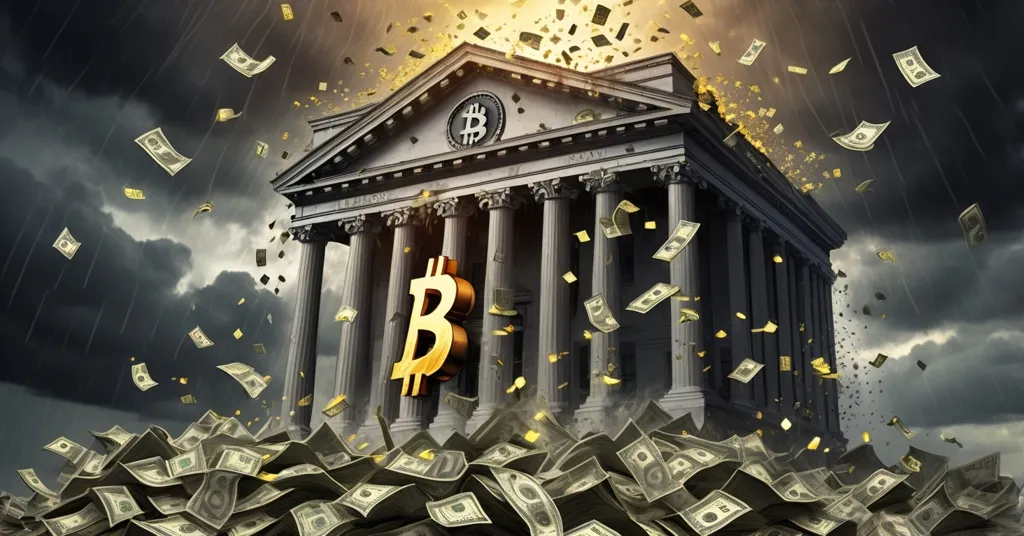Trump’s Fed Power Grab Meets Global Savings Crisis: Can Bitcoin Save Us?

Trump Targets Lower Rates, But a Global Savings Crisis Threatens to Upend Everything
Donald Trump is on a mission to slash interest rates by strong-arming the Federal Reserve, but the real economic tsunami—a shrinking global savings pool, ballooning U.S. debt, and geopolitical distrust—could drown his plans before they even start. With mortgage rates at 7% crushing homebuyers and national debt payments outpacing defense budgets, the cracks in traditional finance are widening. Could Bitcoin and decentralized systems offer a lifeline for those fed up with centralized failures?
- Trump aims to control the Fed by replacing Chair Jerome Powell to force lower interest rates.
- Global savings are vanishing due to retiring Baby Boomers and declining foreign investment in U.S. debt.
- Structural economic pressures, not just Fed policy, are driving borrowing costs higher, with crypto as a potential hedge.
Trump vs. The Fed: A Bare-Knuckle Power Grab
Trump’s top economic priority is clear: get interest rates down, no matter the cost. His strategy? Replace Federal Reserve Chair Jerome Powell with a loyalist who’ll bend to his will. Trump hasn’t minced words, publicly blasting Powell as someone who’s, in his view, holding back economic growth with high rates. He’s even seized on a $2.5 billion cost overrun for the Fed’s headquarters renovation—a project bogged down in a literal swamp—as a political club to bash Powell’s leadership. With the early departure of Fed Governor Adriana Kugler opening a spot for influence, Trump sees a chance to stack the deck at an institution designed to be independent from political whims.
But let’s not kid ourselves. Politicizing the Fed isn’t just a risky game; it’s a direct threat to the firewall between government overreach and monetary policy. The Federal Reserve is supposed to manage interest rates and inflation based on economic data, not presidential tantrums. If Trump gets his way, we could be looking at a central bank that’s less a steward of stability and more a puppet for short-term political wins. And for those of us in the crypto space who value freedom from centralized control, this kind of power grab is a glaring red flag.
Why Cheap Borrowing Is a Relic of the Past
Trump might think swapping out Powell will magically lower rates, but he’s ignoring the brutal truth: the era of dirt-cheap borrowing is over. The U.S. economy is drowning in debt, nearing 100% of GDP—up from just over 30% in 2001. Interest payments on that debt are set to eclipse the Pentagon’s budget, while 7% mortgage rates are strangling the real estate market, especially for younger generations already buried under student loans. Bloomberg Economics doesn’t pull punches, projecting ten-year Treasury rates to stay above 4.5%, potentially hitting 5-6% if conditions worsen. They’ve also raised their estimate of the “natural rate of interest”—think of it as the economy’s sweet spot where growth and inflation balance—from 1.7% in 2012 to 2.5% now, possibly climbing to 2.8% by 2030. In plain English, borrowing costs are sticking high, no matter who’s at the Fed’s helm.
The root of this mess isn’t just U.S. policy; it’s a global savings crunch. For decades, from the 1980s to the 2010s, the U.S. enjoyed low rates thanks to a flood of savings from Baby Boomers socking away cash for retirement and foreign nations like China and Saudi Arabia buying up U.S. Treasuries with their trade surpluses and petrodollars. China’s reserves peaked at $4 trillion before dropping to $3.3 trillion since 2014. But now, Boomers are retiring and cashing out pensions, while foreign investment is drying up. Saudi Arabia is funneling money into domestic projects like Neom, a futuristic mega-city, instead of U.S. debt. The pool of global capital that kept rates low is evaporating, and no amount of Fed tinkering can refill it, as detailed in this analysis on Boomer retirement impacts.
For the uninitiated, U.S. Treasuries are government bonds—IOUs to fund the national debt—long seen as the safest bet in finance. When demand for them drops, the government has to offer higher interest rates to lure buyers, which hikes costs for everything from mortgages to credit cards. That’s why your dream home or car loan feels like a pipe dream right now. And with savings shrinking worldwide, there’s less money to go around for anyone, let alone a debt-hungry U.S. government, a trend explored in this study on savings and interest rates.
Geopolitical Blunders Fuel Distrust in U.S. Debt
Adding fuel to this fire are geopolitical missteps that have shattered trust in U.S. financial systems. Take the U.S. freezing $300 billion in Russian assets in 2022 after the Ukraine invasion. It sent a chilling message to other nations: park your wealth in U.S. Treasuries, and it could be locked up if you step out of line. Imagine a bank freezing your savings over a political spat—would you trust them with more cash? That’s how foreign investors now view U.S. debt. The fallout is real; the Russian rouble has collapsed beyond 110 to the USD, down 25% since August, reflecting ongoing sanctions and distrust, as discussed in this Reddit thread on Russian asset freezes. Even allies are rethinking their reliance on U.S.-centric systems, accelerating de-dollarization talks among BRICS nations and others.
Meanwhile, global capital is being siphoned elsewhere. NATO members, spooked by Russia’s aggression, are boosting defense budgets to 3.5% of GDP, potentially adding $2.3 trillion to Europe’s debt over a decade. Massive investments in AI infrastructure—think data centers powering the tech boom—and green energy upgrades are also sucking up savings. These aren’t minor expenses; they’re tectonic shifts pulling money away from U.S. borrowing needs, driving rates up regardless of Trump’s plans. The world’s savings pie is shrinking, and everyone’s fighting for a slice, a situation highlighted in this piece on Trump and global savings challenges.
The Real Pain for Everyday People
Let’s zoom in on who’s getting hit hardest by this mess: Millennials and Gen Z. With mortgage rates at 7%, buying a home is a distant fantasy for many. Add in student debt burdens and stagnant wages, and you’ve got entire generations priced out of the American Dream. High borrowing costs don’t just hurt big investors; they crush young people trying to build wealth or even just get by. A young couple saving for a down payment now faces loan terms that eat up half their income—hardly a recipe for financial stability. It’s no wonder many are turning to alternative systems, including crypto, for a shot at bypassing a rigged traditional setup.
This generational squeeze isn’t just a statistic; it’s a crisis of opportunity. When centralized finance fails to deliver, people start looking for Plan B. Whether it’s Bitcoin as a speculative store of value or decentralized finance (DeFi) apps for peer-to-peer lending, the appeal of systems outside the Fed’s or government’s reach grows stronger with every rate hike. But is crypto really the answer, or just another gamble? Some insights on this can be found in this discussion on Bitcoin’s value during economic crises.
Bitcoin and Decentralized Finance: A Hedge or a Mirage?
As traditional finance stumbles under debt and distrust, the crypto space is quietly positioning itself as an escape hatch. Bitcoin, often dubbed “digital gold,” thrives in times of economic uncertainty. High debt and rising rates fuel fears of inflation or currency devaluation—conditions that historically drive interest in Bitcoin as a hedge. Look at post-COVID rate hikes: Bitcoin’s price surged as investors sought alternatives to fiat currencies losing value. When trust in centralized systems erodes, as with the Russian asset freeze, a borderless, government-proof asset starts looking mighty attractive. If the Fed gets politicized, who’s to say your savings won’t be next in line for some political stunt? This perspective is reinforced in this analysis of Bitcoin as a safeguard against policy shifts.
But let’s not drink the Kool-Aid just yet. Bitcoin isn’t a cure-all for global economic woes. Its price swings can make a 7% mortgage rate look like child’s play, and scalability issues—think slow transactions and high fees during peak demand—still hamper its use as everyday money. Bitcoin maximalists like myself might argue it’s the purest form of decentralized value, but we can’t ignore the niches altcoins fill. Ethereum, for instance, powers smart contracts—self-executing agreements on the blockchain—that enable DeFi platforms like Aave or Compound. These tools let users lend or borrow without banks, potentially easing the sting of high rates by cutting out middlemen. Imagine earning interest on your savings or getting a loan without a credit check, all outside a system squeezed by U.S. debt.
That said, the road to decentralized utopia is littered with potholes. DeFi isn’t immune to scams—hacks and rug pulls have cost users billions due to buggy smart contracts or outright fraud. Regulatory uncertainty looms large; a politicized Fed or aggressive government could crack down on crypto as a threat to fiat control, especially if de-dollarization gains steam. And let’s not forget the shills promising “$1 million Bitcoin by next week.” I’ve got zero tolerance for that nonsense—crypto adoption must be built on education, not hype. Still, real-world experiments like El Salvador adopting Bitcoin as legal tender or companies like MicroStrategy stacking BTC on their balance sheets show decentralization isn’t just a theory; it’s a growing reality.
This is why the ethos of decentralization—freedom, privacy, and disruption—feels less like a buzzword and more like a survival strategy amid this savings crisis. If centralized systems are buckling under debt and political meddling, shouldn’t we accelerate building alternatives? Bitcoin and blockchain tech offer a chance to rethink finance, even if the path is messy, a sentiment echoed in online forums like this Reddit discussion on Trump’s Fed influence.
Key Takeaways and Questions to Ponder
- What’s Trump’s strategy with the Federal Reserve?
He’s pushing to lower interest rates by replacing Fed Chair Jerome Powell with a loyalist, even using issues like the $2.5 billion Fed renovation overrun as political leverage. - Why are interest rates staying stubbornly high?
A shrinking global savings pool, U.S. debt nearing 100% of GDP, and competition for capital from AI, defense, and infrastructure are driving costs up, with Treasury rates forecast above 4.5%. - How do geopolitical tensions worsen this economic crunch?
Freezing $300 billion in Russian assets in 2022 has eroded foreign trust in U.S. Treasuries, fueling de-dollarization and reflected in the rouble’s collapse beyond 110 to the USD. - Who’s hit hardest by high borrowing costs?
Younger generations like Millennials and Gen Z face barriers to homeownership and wealth-building with 7% mortgage rates and student debt, driving interest in alternative systems. - Can Bitcoin serve as a hedge against this crisis?
Yes, its appeal grows as a store of value amid inflation fears and distrust in centralized finance, though volatility and adoption challenges remain significant hurdles. - What role does decentralized finance (DeFi) play?
Platforms like Ethereum enable tools for lending and saving outside traditional banks, offering potential relief from high rates, but risks like scams and regulation persist. - What should crypto investors watch out for?
Beware of scammers promising guaranteed returns or unrealistic price predictions—focus on education and long-term value to navigate this volatile space responsibly.
Building the Decentralized Future Now
Peeling back the layers of Trump’s rate-cutting obsession and the global savings drought reveals a stark reality: the old financial playbook is in tatters. The U.S. once coasted on cheap debt while Boomers saved and foreign nations bankrolled deficits. That game is up. With retirees spending, China and Saudi Arabia pivoting elsewhere, and geopolitical trust shattered, we’re staring down a future of tighter wallets and higher costs. Trump can rail against Powell all day, but no loyalist will magic up a savings pool that’s drying out faster than a desert mirage.
For the crypto community, this chaos is both a warning and a call to action. We’re not just spectators to centralized failures; we’re architects of what comes next. Bitcoin stands as a sovereign store of value, Ethereum reimagines finance with smart contracts, and the broader blockchain movement pushes against overreach. Sure, scammers and hype-men still taint the space, and I’ve got no patience for their garbage. But if we’re serious about freedom and privacy, now’s the moment to double down on systems that don’t kneel to any single leader or crumbling economic model. If centralized finance can’t save us, isn’t it time we stop waiting and start building the decentralized future ourselves?



